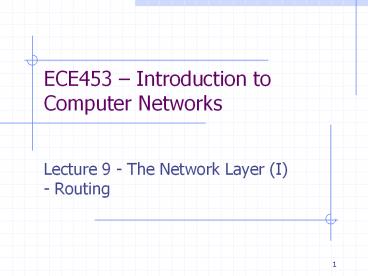ECE453 - PowerPoint PPT Presentation
Title:
ECE453
Description:
ECE453 Introduction to Computer Networks Lecture 9 - The Network Layer (I) - Routing Recap Framing Error detection and correction Reliable or unreliable data ... – PowerPoint PPT presentation
Number of Views:112
Avg rating:3.0/5.0
Title: ECE453
1
ECE453 Introduction to Computer Networks
- Lecture 9 - The Network Layer (I) - Routing
2
Recap
- Framing
- Error detection and correction
- Reliable or unreliable data transfer
- Channel allocation protocol
3
Network Core and Network Edge
Network core
application transport network data link physical
Network edge
application transport network data link physical
4
Network Core Information Transmission
- Circuit switching
- Telephone system
- Message switching
- Mail delivery
- The message travels as a complete unit. At any
one time, it completely exists in one place. - Packet switching
- The Internet
5
Design Issues
- Store-and-forward packet switching
- Services to the transport layer
- Connection-oriented vs. Connectionless
- Quality of service (QoS)
6
Network Layer Services
- Connectionless
- Best-effort
- No guarantee
- The Internet
- No advance setup is needed
- Datagram subnet
- Connection-oriented
- Guaranteed delivery
- ATM
- A path from the source router to the destination
router is established before any data packets can
be sent - Virtual circuit
7
The Internet Network Layer
Transport layer TCP, UDP
Network layer
Link layer
physical layer
8
Routing - In the Middle of Intersection
9
Different Strategies
- Nonadaptive algorithms (or static routing)
- Adaptive algorithms (or dynamic routing)
- Global algorithm (have a global knowledge a
map) - Decentralized algorithm (get information only
from neighbor)
10
Graph Abstraction for Routing Algorithms
- Graph nodes ?? Routers
- Graph edge ?? Physical links
- Edge weight ?? Link cost
- Link cost
- Delay, power consumption, congestion level,
cost, etc. - Good path or optimal path
- Minimum link cost
11
Two Fundamental Routing Algorithms
- Link state routing
- A global algorithm
- Distance vector routing (or Bellman-Ford routing,
Ford-Fulkerson routing) - A decentralized algorithm
- The original ARPANET routing algorithm, replaced
by LS routing in 1979
12
A Link State Routing Algorithm
Dijkstras algorithm
- Net topology, link costs known to all nodes
- accomplished via link state broadcast
- all nodes have the same info
- computes least cost paths from the source to all
other nodes - Iterative algorithm
13
Dijkstras Algorithm An Example
D(B),p(B) 2,A 2,A 2,A
D(D),p(D) 1,A
Step 0 1 2 3 4 5
D(C),p(C) 5,A 4,D 3,E 3,E
D(E),p(E) infinity 2,D
start N A AD ADE ADEB ADEBC ADEBCF
D(F),p(F) infinity infinity 4,E 4,E 4,E
14
Dijkstras Algorithm Discussion
- Algorithm complexity n nodes
- each iteration need to check all nodes, not in N
- n(n1)/2 comparisons O(n2)
- more efficient implementations possible O(nlogn)
- Oscillations possible
- e.g., link cost amount of carried traffic
1
1e
0
2e
0
0
0
0
e
0
1
1e
1
1
e
recompute
recompute routing
recompute
initially
15
DV Routing
- Each router maintains a distance table
- Initialization
- 0 for itself
- Infinity for non-neighbor
- Link cost for neighbor
- Message exchange between neighbors
- When a neighbor first comes up
- When information changes (e.g. change in link
cost) - Distance vector calculation
- Minimize cost to each destination
Iterative routing Distributed routing
16
DV Example
Y
X
Z
17
DV Link Cost Changes
Y
good news travels fast
Z
X
algorithm terminates
18
DV Link Cost Changes
bad news travels slow Count to infinity problem
algorithm continues on!
19
Distance Table An Example
loop!
loop!































